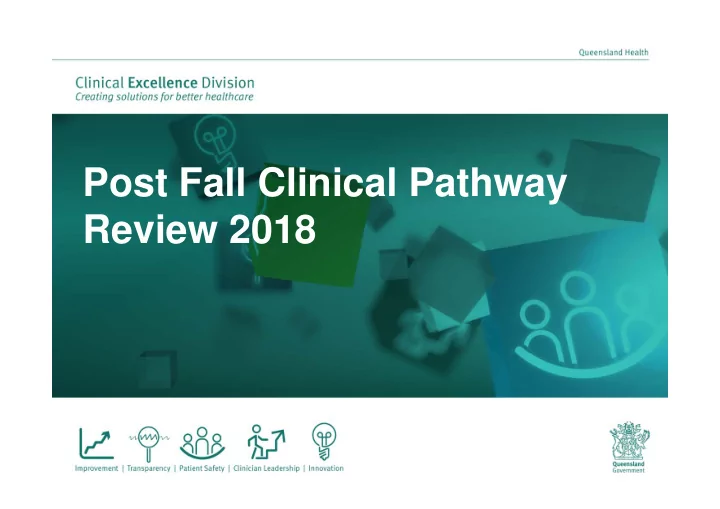

Post Fall Clinical Pathway Review 2018
Post Fall Clinical Pathway (PFCP) Background 2010 – PFCP was developed in response to requests from clinicians for a purpose designed • form to facilitate the implementation of best practice care for our patients in Queensland Health (QH) facilities following a fall. • 2014 – a review was undertaken involving consultation with clinicians from around Queensland, human factors and graphic designers. The review included changes to make the pathway more user friendly. • 2017 ‐ a minor review was undertaken and resulted in changing the Glasgow Coma Scale from 3 to ≥ 2 points to prompt a patient review and align with the Q ADDS. • 2018 – a further review was undertaken in response to recommendations endorsed by the Falls National Standard Reference Group Recommendations included : • o consider related injury other than head injury o adding prompts to consider surgery/biopsy/procedures o include consideration of concealed haemorrhage and other injuries o include consideration of appropriate medical imaging 2
Results of the 2018 review • A review group was established from the state wide Falls National Standard Reference Group consisting of medical, nursing and allied health professionals from around Queensland. The review resulted in the inclusion of the recommendations into the Post Fall Clinical Pathway • • The rationale for this was: *The post fall pathway as it stands predominantly focuses on head injury. *Adding recent surgery/procedure will prompt medical officers to consider this during review of the patient following a fall ‐ this will lead to further investigative imaging. *Consideration of the level of experience and skill – junior medical staff after hours often are the reviewing doctor – adding recent surgery /procedure will prompt them to consider expanding their review to include these. 3
Changes to the Post Fall Clinical Pathway Addition Rationale ‘Injury’ added to Details of fall Prompt to look for injury other than and initial actions head Clinician replaced care giver More inclusive term Recent surgery/procedure Prompt to consider other added to Medical assessments and review surgical Assessment site if patient has had recent surgery or procedure Consider concealed Prompt to consider other haemorrhage added to investigations, assessment Medical Assessment Action and escalate according Prompt for clinicians to action and to score added to escalate patients observations Investigations/observations category Liaise with MO for other Moved from medical assessment appropriate investigations (i.e. section as is a prompt for an x-ray) added to investigation Investigations/observations Indications of internal bleed Prompt to consider symptoms other added to Investigations/ than those related to head injury observations Added to meet 2 nd edition of Transfer of care National Safety and Quality Health Service Standards 4
Post Fall Clinical Pathway • When a patient falls there must be an immediate and urgent response to ensure the clinical wellbeing of the patient. • The Post Fall Clinical Pathway assists in the implementation of a consistent and thorough response to a fall 5
Completing a Post Fall Clinical Pathway • The recommended immediate response to a fall is highlighted in the red bordered box. • Details of the fall and the patient’s vital signs are recorded on the PFCP and observation chart as soon as possible 6
• It is a recommendation that a medical officer is notified of the fall within 15 mins. It is important to record who was notified and at what time • Medical Assessment is used to record the results of the assessment, initial diagnosis investigations, plan of care and recommendations 7
Investigations/observations guide • the care plan for the patient over the next 8 hours, depending on the seriousness of the falls related injury. • Investigations and observations are recommended for a suspected head injury, unwitnessed fall and for other injury such as concealed haemorrhage. These observation will be recorded in the patient observation chart. • Observations documented on the early warning tool must be actioned and escalated as per the recommendations on the tool 8
• The Management Plan within 24 hours prompts the clinician to undertake actions as the result of the fall • Clinical handover is an important action to complete following a fall to communicate for safety • Clinicians documenting in the clinical pathway must supply their details and signature in the signature log 9
10 Thank you
Recommend
More recommend